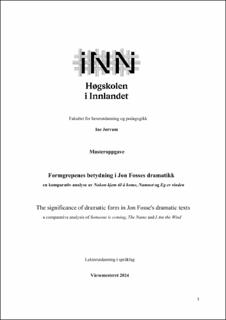| dc.contributor.advisor | | |
| dc.contributor.author | Jørvum, Ine | |
| dc.date.accessioned | 2024-04-02T16:10:32Z | |
| dc.date.available | 2024-04-02T16:10:32Z | |
| dc.date.issued | 2024 | |
| dc.identifier | no.inn:inspera:195548282:30052849 | |
| dc.identifier.uri | https://hdl.handle.net/11250/3124520 | |
| dc.description.abstract | Hensikten med denne oppgaven er å vise frem ulike formgrep som gjenbrukes av Jon Fosse i hans dramatikk, formgrep som litteraturforskeren Pèter Szondi har definert og viser til i sitt eget arbeid. Formgrepene det gjelder avdekker Szondi under det han kaller for «dramaets krise og redningsforsøk», i sin teori Theorie des modernen Dramas fra 1956. Disse formgrepene var en gang radikale og nye formgrep, men de har etter hvert blitt etablerte og klassiske i moderne dramatikk. Fosses dramatikk byr frem en gjenkjennelig tematikk rundt relasjoner og manglende kommunikasjon, når man fokuserer på hvordan karakterene hos Fosse interagerer gjennom språket. Sett fra dette synspunktet kan Fosses dramatikk leses i tråd med tradisjonelle sjangerforventninger, som at dramaet krever en absolutt nåtid og at dramaet er en grunnleggende relasjonell sjanger. Igjennom dette perspektivet kan språket hos Fosse lett forstås som en fremvisning av mangel på kommunikasjon og fellesspråk i sosiale relasjoner eller avhengighetsforhold. Resepsjonen rundt Fosse inneholder ofte begreper som tomhet, meningsløshet, kommunikasjonssvikt, isolasjon og ensomhet. Mitt synspunkt i denne oppgaven er imidlertid at denne forståelsen innebærer et begrenset perspektiv som gjør at man muligens går glipp av mangfoldet og betydningsbredden i Fosses dramatikk. Hensikten med å undersøke hvordan Fosse gjenbruker formgrepene som Szondi har definert, handler om å vise hvordan disse formgrepene er med på å utvide betydningsrommet og det tematiske fokuset på kommunikasjon og relasjoner i de tre utvalgte dramatekstene. Det vil si at disse formgrepene, når vi først fokuserer på dem, forskyver eller korrigerer en tematisk lesning av Fosse som konsentrerer seg om en kommunikativ og relasjonell problematikk. Resultatet er at disse formgrepene bidrar til en tematisk utvidelse og en tematisk dobbelthet. Det i Fosses dramatekster som pekte mot kommunikasjon og det relasjonelle, peker nå også i retningen av noe eksistensielt, noe som er større enn oss mennesker, og som angår hvordan de store sammenhengene gjør menneskers liv viktig og meningsfullt.
| |
| dc.description.abstract | Title: The significance of dramatic form in Jon Fosse's dramatic texts a comparative analysis of Someone is coming, The Name and I Am the Wind.
The purpose of this master’s thesis is to show various dramatic forms that are reused by Jon Fosse in his dramatic texts, which the literary researcher Pèter Szondi has defined and refers to in his own work. The dramatic forms in question are covered by Szondi under what he calls "The Drama in Crisis and Rescue Attempts", in his theory Theorie des modernen Dramas from 1956. These dramatic forms were once radical and new forms, but they have gradually become established and classic in modern drama. Fosse's dramatic texts presents a recognizable theme around relationships and lack of communication, when you focus on how Fosse's characters interact through language. Seen from this point of view, Fosse's dramatic texts can be read in line with traditional genre expectations, such as that the drama requires an absolute present and that the drama is a fundamentally relational genre. Through this perspective, Fosse's language can easily be understood as a demonstration of a lack of communication and common language in social relationships or dependency relationships. The reception around Fosse often contains concepts such as emptiness, meaninglessness, failure of communication, isolation and loneliness. My point of view in this master’s thesis, however, is that this understanding implies a limited perspective which means that one possibly misses out on the diversity and breadth of meaning in Fosse's dramatic texts. The purpose of examining how Fosse reuses these dramatic forms that Szondi has defined is to show how these forms help to expand the space of meaning and the thematic focus on communication and the relational in the three selected drama texts. That is to say that these forms, when we first focus on them, alter or adjust the thematic reading of Fosse that concentrates on a communicative and relational problematic. The result is that these dramatic forms contribute to a thematic expansion and a thematic duality. That in Fosse's drama texts which pointed towards communication and the relational, now also points in the direction of something existential, something bigger than us humans, and which concerns how the large connections make people's lives important and meaningful. | |
| dc.language | nob | |
| dc.publisher | Inland Norway University | |
| dc.title | Formgrepenes betyding i Jon Fosses dramatikk
en komparativ analyse av Nokon kjem til å kome, Namnet og Eg er vinden | |
| dc.type | Master thesis | |
